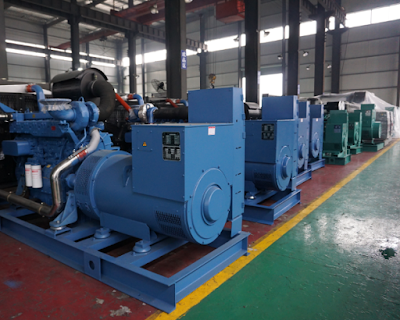The compression ratio of diesel engine is the ratio of the total cylinder volume to the combustion chamber volume. The change of the compression ratio not only affects the power and economy of the diesel generator, but also affects its start-up performance. Each diesel engine is designed with an optimal compression ratio, but in use, the compression ratio is often reduced due to the influence of various related factors. The main reasons for the reduction of the compression ratio of the diesel engine and some problems that should be paid attention to in the course of maintenance are summarized as follows:
I The piston is low at the end of compression
1. The matching clearance of related parts is too large. When the clearance between the crankshaft main bearing and the main journal, the connecting rod bearing and the connecting rod journal, the connecting rod bushing and the pin sear hole is too large =, during the compression process, the actual position of the piston stop point will often move down, reducing the compression ratio. Therefore, these fit gaps should be controlled within the allowable range during repair.
2. The relevant parts are deformed or the main dimensions are extremely poor. For example, when grinding the crankshaft connecting rod journal, the eccentric distance is not adjusted well, so that the rotary radius of the crankshaft after grinding becomes smaller. The bending of connecting rod shortens the enter distance between the big and small end holes of connecting rod. The often of piston pin seat hole makes the distance between the center line of piston pin seat hole and piston top plane shorter. All these factors will cause the piston to move down and the compression ratio to decrease. Therefore, the quality of repair should be guaranteed by following the operation standard. At the same time, do not forget to change the inspection, do not change or install unqualified parts. When changing parts, the contents should be checked: crankshaft radius of rotation, center distance of big connecting rod and small end hole, distance from center line of piston pin seat hole to piston top plane, distance between upper plane of body and center line of main bearing hole.
II Combustor volume is larger
1. The valve and valve seat are badly worn and the valve sink is too large (or even beyond the limit). Valve and seat ring should be replaced at this time.
2. The cylinder cushion thickness exceeds the design requirement, or increases the cylinder cushion thickness artificially. The required cylinder pad shall be replaced at this time.
3. Piston top pit (part of combustion chamber) ablation defect, or the wrong parts, so that the pit volume is too large (can be checked by water injection contrast method). A qualified piston should be replaced at this point.
4. The swirl chamber on the cylinder head is burnt, or the quality is not up to standard, the volume is too large (can be checked by water injection contrast method). A qualified cylinder head should be replaced at this time.
It is worth mentioning that among the factors that lead to the reduction of compression ratio, the single factor is not very important, but the effect of accumulation and superposition of multiple factors on compression ratio is great. As mentioned above, in order to control the compression ratio of diesel generator sets within a specified range, the key lies in improving the repair quality and doing the repair, measurement and selection of the parts. To the extent permitted by the technical requirements, select as small as possible assembly clearance. When the diesel engine is difficult to start, the power decreases, the fuel consumption rises, the cylinder seal, the gas distribution and the fuel supply are all normal, it seems that the reason of the failure can not be found, and the check of the compression ratio should not be ignored.
Causes and treatment methods of reducing Insulation Resistance of Generator
The insulation resistance of the generator decreases as follows: the insulation resistance of the generator is less than 0.5 M Ω under the thermal stability and less than 2 M Ω in the cold state. What causes the insulation resistance to decrease, and what are the corresponding treatment methods?
I failure cause
1. Diesel generator set are stored in wet conditions for a long time, or in the process of transport the motor winding is dampened.
2. During maintenance, the insulation of motor winding is damaged.
3. Conductive dust in the air, such as metallurgical industrial zones, or acid / alkaline vapours, such as chemical industrial zones, enter the motor and corrode the electrical insulation.
4. Generator winding insulation natural aging.
II Corresponding processing method
1. The ventilation condition of generator storage environment is improved, the damp generator is dryly treated, and the three-phase outlet of generator stator winding is connected directly and fastly. The voltage regulator in the excitation circuit is adjusted to the position of the maximum resistance, the generator is started, the speed is accelerated to the rated speed, and the excitation current is adjusted. The stator winding short circuit current shall not exceed the rated current. The drying time depends on the short circuit current and the damp condition of the generator.
2. Replace the insulation damaged winding or tank.
3. Improve the environment of the generator or transfer the installation of the generator.
4. Overhaul the generator, replace the winding and insulating material or replace the new generator.

Comments
Post a Comment